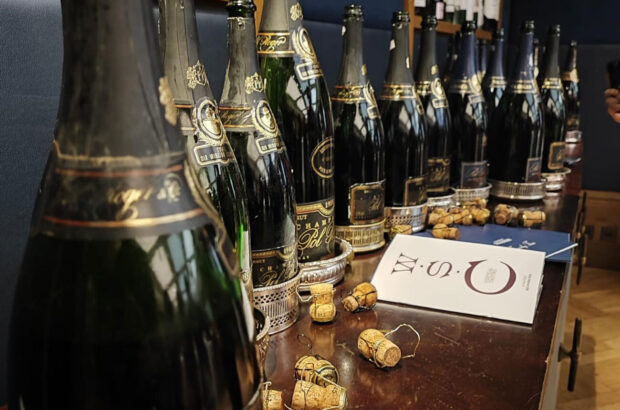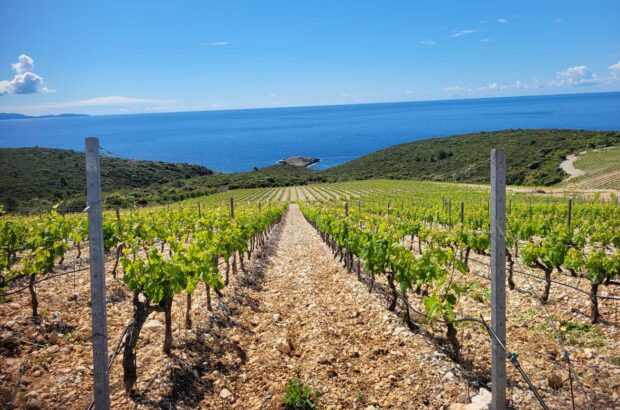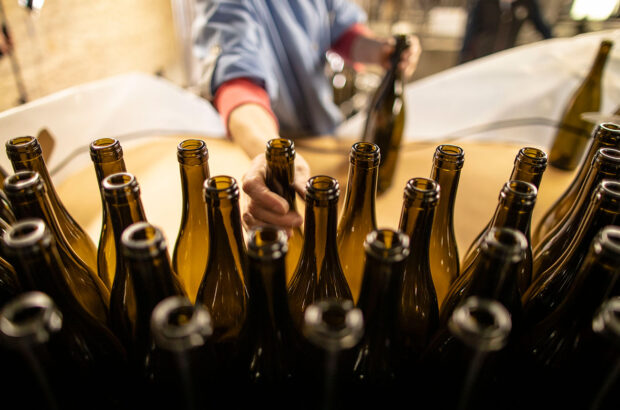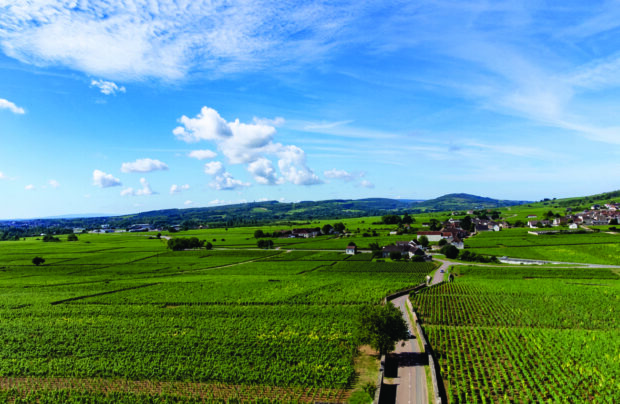- Wine drinkers should soon discover that the heartbeat of Provence lies in the hills rather than along the coast.
- The key to quality in the Coteaux Varois is the elevation of the vineyards.
- The appellation consists of 65 independent producers and 12 caves cooperatives.
The Collins Compact Dictionary describes a Cinderella as: ‘1 Person who achieves fame after being obscure; and 2 Poor, neglected or unsuccessful person or thing’. The Coteaux Varois appellation, struggling to step into the limelight enjoyed by its bigger, elder sister, Côtes de Provence, fits the first description. Wine drinkers should soon discover that the heartbeat of Provence lies in the hills rather than along the coast.
The key to quality in the Coteaux Varois, a disparate appellation of 1,800 hectares (ha) that straggles across 28 communes in the central and northern Var, is the elevation of the vineyards. Vines are planted at altitudes of up to 500 metres, with an average of 350 metres, and the climate is continental rather than Mediterranean, cold in winter, hot and dry in summer, akin to that of Piemonte. Vintage date is at least two weeks behind the Côtes de Provence, and yields are lower, producing wines that are full of character. So spread out are the vineyards that the only thing they share in common, apart from the elevation, is a chalky-limestone soil, which adds elegance to character.
In 1973, the year that Côtes de Provence passed from VDQS (Vin Délimité de Qualité Supérieure) to AC (Appellation Contrôlée), Coteaux Varois was created as a Vin de Pays. In 1984 it was upgraded to VDQS, and in 1993 was awarded full AC status. Suggestions by the Syndicat des Vins Coteaux Varois that it join the Syndicats of Côtes de Provence, Coteaux d’Aix, Coteaux des Baux and Côtes de Luberon for joint international promotion of Provençal wines were rebuffed. None of them wanted the newcomer at the ball. The Varois response was to open up shop in the beautiful 11th-century cloisters of L’Abbaye de la Celle, just outside Brignoles, to persuade France’s six-star chef Alain Ducasse to take over the adjoining Relais et Châteaux Hostellerie and to continue doing its own thing.
At the moment, the appellation consists of 65 independent producers and 12 caves cooperatives, producing an average of 11 million bottles, broken down into three percent white, 27% red and 70% rosé. Export only represents five percent of the total production of the region, so many properties stick to rosé for an easy sale. Over a couple of days in January, I visited a few of those who prefer to be different.
Château Margillière
This large 90ha estate on the edge of Brignoles was eking out a deprived existence and was down to 15ha of vines before being purchased by local entrepreneur, Patrick Caternet, in 1996. Now nothing is too good for it: stainless steel tanks, new wood, tall Italian bottles, but above all the oenologue Emmanuel Gaujal, known in the region as le magicien du blanc. Rolle (Vermentino) is the white grape of choice in the region, making a distinctive wine that is lightly floral, ripe, yet crisply dry. Blended with up to 20% of the old workhorse Ugni Blanc, which adds a little roundness, it is delicious. The rosé (80% Cinsaut, 20% Grenache) is pale, charmingly fruity, and the red (50% Grenache, 20% Cabernet Sauvignon, 20% Tibouren, 10% Mourvèdre) robust and firm. A property to watch.
Château Miraval
Certainly the most beautiful domaine in the appellation, with 300ha of woods, lakes, farmland and olive trees planted on restored Roman terraces. The 28ha of vines are unique in that the white wine is Coteaux Varois, while the red and rosé are Côtes de Provence. The white is 100% Rolle, and a vertical tasting from 1999 down to 1994 showed how extraordinary this varietal can be. The grapes ripen well into October to attain more than 13 degrees of alcohol with no loss of acidity. Fermented at low temperatures and bottled after 10 months in tank, the 1998 had the ripeness of an Alsace with citronella fruit and the length of a fine Graves. The 1994 had taken on the almondy, honey flavours of a Barsac, while remaining dry – quite a revelation.
Château La Calisse
Another stunning property that was rescued from near abandon by Patricia and Jean-Paul Ortelli in 1991. The stoney-chalky soil was extensively drained, the vineyard totally replanted at 380 metres on a north–south axis, and farmed organically. There are four hectares of white, mostly Rolle, and four of Syrah, Grenache and Cabernet Sauvignon, which Patricia Ortelli tends as if it were a large garden. Her intention – to make a wine whose fruit reflects the marriage of grape and soil – is shown by an aromatically seductive barrel-fermented white, a beautiful
Contact details:
Château Margillière, Tel (33 4) 94 69 05 34, Fax (33 4) 94 69 33 11.
Château Miraval, Tel (33 4) 94 86 39 33, Fax 33 4) 94 86 42 63.
Château La Calisse, Tel (33 4) 93 99 11 01, Fax (33 4) 93 99 06 10.
Domaine des Alysses, Tel (33 4) 94 77 10 36, Fax (33 4) 94 77 11 64.
Château Routas, Tel (33 4) 94 69 93 92, Fax (33 4) 94 69 93 61.
Domaine de Trians, 83136 Neoules. Tel 4 94 04 08 22, Fax 4 94 04 84 39.
UK importers:
Chateau Miraval: McK
Chateau Routas: M&V
Domaine de Trians: Dec
Syrah-Grenache rosé, and a red that is an explosive combination of blackcurrants and hung game. These are very polished and sophisticated wines.
Domaine des Alysses
Although this domaine has been organic for 23 years, having been awarded, as has La Calisse, the Contrôle ECOCERT stamp of approval, comparisons stop there. Jean-Marc Etienne was a teacher in Aix-en-Provence in 1968 when he decided to chuck it in and make wine instead. He and his wife applied for aid from the government as jeunes vignerons and obtained three hectares off the Barjols-Draguignan road, the most northerly point of what is now the Coteaux Varois appellation. He now has 12ha of his own and rents a further six, producing a little Chardonnay, which makes a lively, floral vin de pays, but mostly Grenache, Carignan, Syrah and Cabernet Sauvignon for his exceptional reds. The Cuvée Prestige 1996 (60% Grenache, 20% Syrah, 20% Cabernet) has a deep velvety colour, lots of spice and grip over a wonderful extract of fruit. Jean-Marc is a close friend of Eloi Durrbach of Domaine de Trevallon and it shows in this wine. While 80% of his production is exported, not a bottle comes to the UK, which seems a pity.
Château Routas
Lost in the forest behind the village of Châteauvert with the highest elevation of the appellation, lies the 45ha vineyard of Routas that is the passion of Swiss–Canadian cranberry tycoon Philippe Bieler. Constantly experimenting with different blends and different names for these blends, Bieler keeps each varietal separate until he decides what he wants to do with them. Tasting the 1999s unblended, he produced a Puligny-Montrachet-style Chardonnay from very low yields, a Viognier that would rival much of the produce of Condrieu, a magnificent Grenache from 45-year old vines, and a most exciting Syrah that could well have come from Qupé in Santa Barbara County. The 1997 version, still 100% Syrah and thus downgraded to a vin de pays, had fruit literally jumping out of the glass, backed by supple oak and marvellous grip. This is called ‘Cyrano’. His 1997 Coteaux Varois 50% Grenache, 25% Syrah, 25% Cabernet Sauvignon blend, ‘Infernet’, is as solid, spicy and plummy as one could hope for. The whites, ‘Pyramus’, a Rolle-based blend, and ‘Coquelicot’, from 60% Chardonnay and 40% Viognier, both have lovely barrel-fermented fruit; the ‘Rouvière’ rosé is delicate and delighful.
Domaine de Trians
Here I must declare an interest: the owner, Jean-Louis Masurel, is a good friend and it was with him that I stayed in January while researching this article. I am thus prejudiced in favour of his wines, as is everybody who comes to Trians and meets Jean-Louis, whose gentleman farmer exterior hides a passionate commitment to his unique terroir. Domaine de Trians, (not to be confused with Domaine Triennes, owned by Jacques Seysses and Aubert de Villiane, in the west of the appellation near Sainte-Maximin), is the most southerly Coteaux Varois vineyard and is remarkable for its northeastern exposure, which means that it is always the last to harvest. Yet another of the region’s very run-down estates, for profits were rare and investment non-existent, Masurel saw the potential in the low-yielding old vines and purchased the property in 1989. To the nine hectares of very mature Grenache, Cinsaut and Ugni Blanc, he has added 11ha, with five of Syrah, three of Sémillon, Rolle and Viognier, two of Grenache, and one of Cabernet Sauvignon. Current production is 60% red from yields not exceeding 30 hectolitres/ha (compared to 60 in the Médoc), 20% white and 20% rosé. Tasting the stunning 1999s from tank and barrel with Jean-Louis and his oenologist and mentor Jacky Coll (see below) it is clear that their investment and dedication over the last decade has paid dividends and has turned Trians into one of the region’s leading domaines.
Other good Domaines
The Syndicat put on a comprehensive tasting for me to include all the members’ wines whose estates I did not have time to visit. From this, the following stood out:
White
Domaine des Chaberts, Domaine de Loou, Domaine de Saint-Jean le Vieux, Château Thuerry.
Red
Les Cabians (Château de la Bessonne), Domaine des Chaberts, Domaine Saint-Jean de Villecroze, Château La Curnière, Château Duvivier and, especially, the splendid Clos de la Truffière from the old, established Domaine des Deffends.
Armed with wines like these, and especially with the driving force of the domaines mentioned above, the Coteaux Varois is set firmly on the quality route. Selling its wines outside the region is not easy and, while there is always a ready market for rosé, my view is that the strong cards of the appellation are Rolle-based whites and the Grenache-Syrah reds, with or without a dash of Cabernet. These, in the right hands, are grands vins de terroirs.
It is recognised in the appellation (and to the north in the Luberon) that the best pair of hands belong to the consultant oenologist Jacky Coll. Now in his 50s, Coll has dedicated his life to the vineyards of Provence and describes himself simply as un homme de la vigne. His rules are few: good terroir, grape varieties that suit it, planting at 4–5,000 low-trained vines per hectare, yields between 30 and 35 hectolitres/ha, except for rosé, and respect for the soil in cultivation. What he is looking for is natural concentration and richness in the grapes, and he is not afraid of tannin. He is not that keen on Cabernet Sauvignon and abhors Merlot, preferring local grapes that, properly handled from start to finish, produce true vins d’origine. To this end, he favours maturing the structured red wines en masse for 24–28 months before bottling, by which time, with a further six months’ bottle age, they will be good to drink. And although he is a man of very firm convictions, difficult to influence, Jacky Coll also insists that the wine should always reflect the image of the owner. Asked what his perfect domaine would be, he replied: ’20ha of well-sited, mature vines, producing 10% white, 30% rosé and 60% red.’ Perhaps that is why he fits in so well at Domaine de Trians.












